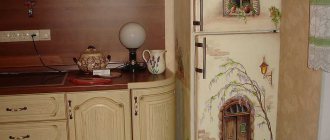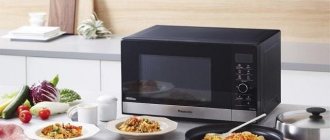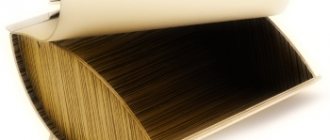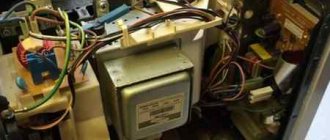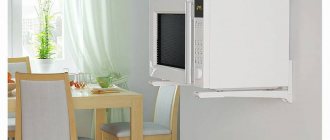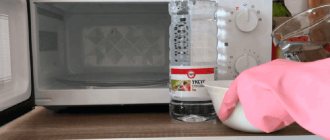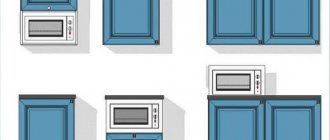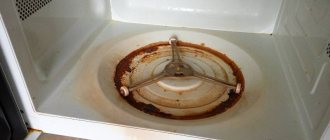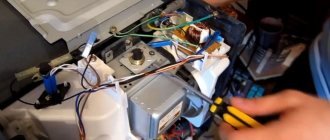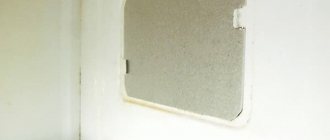Over time, the oven enamel becomes deformed, so it becomes necessary to restore the heat chamber. Few people know how to paint the inside of a microwave; first of all, this has to do with the choice of paint material. The paint used must not contain toxic substances. It is extremely important that it is resistant to high temperatures.
The conditions inside the furnace are extremely specific. Electromagnetic waves constantly increase the amplitude of vibrations of water molecules. Dynamic temperature changes lead to cracks and scratches appearing on the inner coating.
Causes of coating deformation
Fat and food debris accumulate on the walls of the heat chamber, so the surface must be washed regularly. Using a hard brush and abrasive detergents will lead to deformation. What to do if chips appear inside the microwave or the enamel is cracked? It is necessary to immediately begin restoring the coating material.
Damage to the integrity of the enamel is a catalyst for worsening the problem. Scratches and other damage will contribute to corrosion and rust. It is possible that other defects will appear. Their specificity largely depends on what material the walls of the heat chamber are made of. Microwave paint is the optimal solution to the problem.
Is it possible to use a microwave with damaged enamel?
When the paint inside the microwave peels off and peels, the owners do not refuse to use it. The walls of the heat chamber are covered with enamel to protect food heated in the oven from electromagnetic radiation. To restore the original level of protection, you need to paint the inside of the microwave.
Electromagnetic waves will not penetrate into the heat chamber through minor cracks. However, the microwave will still have to be repaired. Gradually the number of damaged areas will increase. Is it possible to use a microwave if the enamel has peeled off? Theoretically, yes, but as the deformation increases, the furnace will have to be restored or disposed of. Is peeling enamel in the microwave harmful to humans? The remains of the material themselves do not pose a threat to the body, but microwaves penetrate through the cracks, which negatively affect the heated products.
Which paint to choose?
So, how to paint the inside of a microwave oven? It should be noted right away that the paint must meet certain standards: the composition must be non-toxic, withstand high temperatures, and not succumb to aggressive influences.
The following types of paints are perfect for microwave ovens:
- Organosilicon. This paint inside the microwave creates a layer that is resistant to many adverse factors. Suitable for restoring metal surfaces. It has a high cost, but at the same time has a certificate of quality.
- Electrically conductive. It is used for interior decoration of microwave ovens, but rarely due to its high cost. The paint layer is covered with a zinc film, which protects the surface from damage and damage and completely restores previous damage. Among the most popular products is Zinga paint.
- Fire retardant paint for metal. It is most often used if the outer part of the equipment body has peeled off. The inside of the microwave oven is not painted, since the fire-retardant emulsion is not food grade.
- Acrylic primer for cars. Completely harmless and inexpensive. It is better to purchase the material in a can - it has less consumption. The coating is durable, high quality and resistant to elevated temperatures.
Microwave ovens need to not only be painted with the chosen paint, but also done correctly. Many people think: “I’ll paint it lightly, filling up areas with obvious defects.” This solution is completely unsuccessful, as it will lead to complete damage to the internal part of the microwave.
On video: how to transform the appearance of a microwave.
Types of coating
Peeling heat chamber enamel is not yet a reason to throw away your microwave oven. It is possible to restore household appliances. It is necessary to coat the inside of the microwave with special paint. Painting the inside of a microwave makes it possible to increase the service life of the device by several years. The causes and specifics of deformation are determined by the type of coating.
Features of ceramic surface:
- maximum hardness, but high risk of scratches;
- Due to mechanical stress, chips and cracks also appear;
- smooth surface prevents the accumulation of fats;
- Easy to clean; a foam sponge and soap solution will be enough for cleaning.
Advantages and disadvantages of stainless steel:
- strength, reliability, resistance to temperature fluctuations;
- It is extremely difficult to remove grease contamination;
- It is prohibited to use abrasive cleaning products;
- cleaning is carried out with steam or special cleaning liquids for microwave ovens.
Everything you need to know about enamel coating:
- food enamel has a limited service life;
- used primarily in budget microwave ovens;
- no pores, smooth, easy to care for, grease and dirt are easily removed;
- deformed due to regular use;
- bubbles appear, total destruction occurs;
- the enamel falls off in pieces, rust appears;
- the material peels off on the bottom and ceiling, this is due to increased exposure to hot steam;
- the structure of the material is damaged under the influence of steam, high temperature, and detergents.
What to do if you don’t paint the inside of the microwave in a timely manner? During operation, the stove will crack and spark. Ignoring the problem will lead to complete failure of the equipment.
How to paint a microwave and is it possible to do it in principle? Only the enamel surfaces of the heat chamber can be opened with paint and varnish material. In other cases, the equipment should be disposed of.
Types of microwave oven coatings
To decide on the type of paint needed, you first need to familiarize yourself with the types of existing coatings for microwave ovens.
- Enameled coating is the most popular in the production of microwave ovens, due to its low price. But it is worth noting that such a surface is too easily susceptible to negative influences: steam, grease, the mechanical impact of rollers rotating the plate, and so on. To prevent the enamel from peeling off prematurely, it must be carefully cleaned immediately after contamination (since it scratches easily). If this process is delayed, dirt and grease will penetrate the pores of the material. It is also recommended to wipe the surface dry each time after use.
- Ceramic coating is practical. This material is very smooth, making it difficult for dirt to stick to it. It is durable, but you should not abuse it - rough impact may cause mechanical damage in the form of chips and cracks. It is recommended to clean the ceramic coating with soapy water and a soft sponge.
- Stainless steel cover. This surface can withstand very high temperatures and has a long service life. However, it is quite difficult to get rid of fat and smudges. Contaminants must be removed using special products that do not contain abrasive particles that will scratch the coating. Various acids should also be excluded, because they leave behind dark spots that cannot be removed.
What paint can you use to paint a microwave?
Not any paint coating is suitable for painting a heat chamber. Few people know what paint can be used to paint a microwave. This negative trend is due to a lack of information. The paint you choose must meet the following requirements:
- 100% match to original color;
- resistance to abnormally high temperatures;
- absence of toxic compounds.
Mostly, microwave oven owners who discover that the heat chamber is deformed throw away the household appliance and purchase a new one. If you want to save money, but are unsure how to paint your microwave oven, then you need to familiarize yourself with the criteria for choosing a paint material.
Food grade or organic
The optimal paint brands for microwave ovens are KO-5102 and BEP-5297. Food-grade paints and varnishes have only one significant drawback - overpriced. There are many more advantages:
- organic brands cope well with abnormal temperature conditions;
- resistance to high humidity;
- absence of toxic compounds;
- corrosion prevention;
- water resistance.
The layers of organic paint inside will last quite a long time. Organic paints and varnishes are approved by the Ministry of Health, therefore they are mainly used in the food industry. They have excellent adhesion to various surfaces. The coating must be applied with a brush or roller.
Electrically conductive
If the microwave enamel chips, buy Belgian Zinga paint to restore the equipment. Enamel KO-8111. These materials contain all the necessary components: silver, zinc, aluminum, etc. Leave the painted enamel coating of the microwave for several hours. Immediately after drying, the material turns into a layer of increased strength, which has maximum resistance to various negative influences.
Electrically conductive paint can maintain its integrity at a temperature of 200 degrees. Particularly noteworthy is the excellent grip on the surface. This material is mainly used by stove owners because of its low price.
Shungite
Shungite is a type of paint and varnish coating with a maximum level of electrical conductivity. It has strength and density. Heat-resistant and antistatic bases are made from this paint. If the old microwave enamel is peeling off, use shungite paint, as it also helps save energy.
Due to its increased durability, this paint is ideal for microwave ovens. Do not forget that it is important not only to choose the right material, but also to apply it. How to paint a microwave at home? No special equipment or skills are required for this. You just need to follow expert recommendations.
Acrylic car
Is your microwave's old paint chipped or peeling? It is necessary to restore peeling enamel at home. If the previous materials did not suit you for some reason, then you need to get acrylic paint. This is a very easy material to use and is also inexpensive. Sold in cans. Applying acrylic paint to enamel is not difficult. One can will be enough. One coat is enough.
Types of paints
There are the following main types of paints and enamels used for processing microwave ovens.
Special organic food
This is perhaps the best option, although not the cheapest. Such coatings are absolutely resistant to all types of adverse influences, such as elevated temperatures, alcohol fumes, acids, high levels of humidity, and are safe for health . The compositions from which they are made are developed specifically for the food industry. Organic paints work best on aluminum or metal.
Enamels for the food industry are standardly used for painting containers intended for storing drinking water and other products, so the substances used to create them meet the most demanding requirements. They are a combination of zinc powder and a specially processed alcohol solution.
Enamels perfectly protect the microwave from the formation and development of corrosion due to the so-called “cold galvanizing”, withstand temperatures up to 100 0C and are very water resistant.
Electrically conductive
The composition of such paints can be developed on the basis of zinc, aluminum, silver or shungite. After drying, the coating becomes resistant to negative external factors and can withstand temperatures up to 150-2000C. Despite all their advantages, they are rarely used in everyday practice because their price is high.
Shungite
Shungite is a rock characterized by its high energy-saving function. One ton of rock contains 300 kg of shungite carbon, which is significantly more active than coke. Shungite is distinguished by such properties as electrical conductivity, strength and density, which make it ideal for creating heat-resistant and antistatic bases. Therefore, such options are perfect for microwave ovens.
How to paint the inside of a microwave at home, instructions
Now you know how to paint the inside of a microwave. The type of material used is also extremely important. To do everything correctly, follow the simple step-by-step instructions:
- Unplug the equipment. Place the device on a flat surface with the door facing up so that access to the equipment is not restricted.
- Seal the air duct, wave duct, and other compartments that you don't want paint getting into with tape or tape.
- Clean the surface of old paint that has peeled off. If the coating on a certain wall is not damaged, then it can be left untouched.
- If you do everything in a timely manner, then rust should not have appeared. It is necessary to clean damaged areas and uneven areas with sandpaper.
- If the rust has spread sufficiently, you need to treat these areas with a special acid converter.
- Immediately after completing the process of cleaning the peeling areas of enamel, remove dust and dirt from the surface with an ordinary rag.
- Be sure to degrease the surface with special products or regular alcohol.
- Follow basic safety rules. You need to work exclusively with gloves. Be sure to provide proper ventilation in the room. It is advisable to apply layers of paint outdoors.
- To prevent dirt from accumulating in the workplace, you need to lay a special oilcloth or film on it; newspapers are a good alternative.
- If you plan to spray paint your microwave, then place it on edge. Start painting with recessed surfaces.
- To prevent drips, do not put too much paint on the roller, which should be applied in a thin layer. The corners must be painted with a brush.
- When the first layer of paint is completely dry, apply the second layer using the same principle.
- Paint from spray cans is applied in a zigzag pattern; there should be no delays. This will allow the layer to be applied evenly.
- After final drying, evaluate the work done and, if necessary, apply another layer.
- When everything is dry, you can remove the tape. Wait for the paint to fully adhere to the surface.
- After restoration work is completed, the stove should not be turned on for several days.
To maximize the effect of painting your microwave oven, regularly remove grease and food debris from the surface of the heating chamber. This can be done with a sponge soaked in soapy water or special cleaning products. If you find a peeling area, paint over it immediately to prevent the damage from getting worse.
Coloring stages
Now you know that even if the enamel peels off in the microwave, you can still restore the integrity of the surface. However, it is extremely important to apply the paint material correctly. Conventionally, the coloring process can be divided into 4 stages:
- Bubbling, rusty and flaking areas should be carefully cleaned using sandpaper.
- The surface on which paint will be subsequently applied is degreased with an alcohol solution.
- It is extremely important that no paint splashes get into the important hardware compartments of the oven, so they are sealed with tape.
- The dyeing process itself. The second layer is applied at the discretion of the user. The decision is made only after complete drying.
After reading this step-by-step instructions, you will know what you can use to paint a microwave if the enamel has peeled off, as well as how to do it correctly.
Types of paints suitable for painting the inside of a stove
The list of things that can be used to paint the inside of a microwave oven, observing the above conditions, is small:
- The best choice is food coloring, made from silicone varnish to which fillers and coloring pigments have been added. It is approved by the Ministry of Health and recommended for use in the manufacture of food containers. Withstands temperature fluctuations and high humidity without consequences. It is not destroyed by adverse influences. When heated, substances hazardous to health are not released. Painting is done in 1 - 2 layers using a roller or brush. The disadvantage is the high cost.
- Electrically conductive compounds. An example of this type of coating is Zinga, produced in Belgium. After drying, a layer of zinc is formed on the surface, able to withstand heating up to 150°C, resistant to adverse influences. The paint adheres perfectly to the metal surface and does not poison food with harmful secretions. However, the cost is decent.
- Acrylic-based car primer is used not only for painting microwave ovens, but also other household appliances. Its price is low, it is sold in the form of a spray, which allows you to paint quickly and conveniently. When painting a microwave, one can is enough to create a 2-layer coating. After application, the primer firmly adheres to the metal surface, tolerates the required temperature range without problems, and does not poison food. A wide selection of colors allows you to accurately select the desired shade.
- Enamel for restoration of coatings. Epoxy enamel is used for its manufacture. Used to restore enamel surfaces of household appliances. It adheres well to metal to form a durable, resistant layer that can withstand heating up to 100°C. The disadvantages include a poor range of colors.
- Temperature-resistant paint HI-TEMP SPRAY PAINT. Withstands high temperatures, can be applied even to rusty surfaces. Used for painting heating equipment, heat exchangers, and other surfaces exposed to high temperatures. Low cost. And also Heat-resistant paint HI-TEMP SPRAY PAINT - it will withstand heating up to 600 degrees.
How to paint the inside of a stove from rust
What to do if the microwave is rusty? This problem occurs because the inner walls of the heat chamber were deformed, but the user ignored this. The natural result of corrosion will be the appearance of rust in the microwave. There are several ways to carry out recovery.
The first and best option is painting with food paint. It is made from organosilicon varnish. Manufacturers of this coating add special pigments and fillers to the composition. It was previously noted that organic paint is approved by the Ministry of Health. It is mainly used for processing food-related equipment.
There are several obvious advantages to this method of removing rust from a microwave. Firstly, it is resistant to high humidity. Secondly, when exposed to high temperatures, food coloring does not release harmful substances. Painting is carried out in several layers. A roller or a regular brush is used for this.
An electrically conductive composition is another effective option for getting rid of rust in the microwave. Immediately after drying, a zinc layer appears that can withstand heating up to 150 degrees Celsius. The paint and varnish material fits perfectly on metal surfaces. It is quite expensive, but does not have toxic compounds.
Acrylic based automotive primer can also be used to combat corrosion. It's quite cheap. Sold in cans. It applies very quickly and extremely easily. One can is enough to create a two-layer coating. Acrylic exhibits excellent adhesion to metal surfaces. Copes with non-standard temperature conditions.
Enamel for restoring coatings is also suitable in cases where the microwave has rusted. It is made from epoxy enamel. It is used specifically for restoring the surfaces of household appliances. Works great on metal surfaces. Forms a strong and durable layer that can withstand up to 100 degrees Celsius. As for the shortcomings, the range of shades leaves much to be desired. There may be problems with choosing.
Also pay attention to the HI-TEMP SPRAY PAINT. It is designed for operation in environments with abnormally high temperatures. Capable of withstanding enormous loads. Can be applied even to rusty surfaces. Mainly used in the process of painting radiators and other elements of the heating system. Among the advantages, one should also highlight the relatively low cost.
Food enamels
Lakokraska-Ya Catalog LKMPFood enamels
Dye
Enamel
Silicone enamels KO and OS compositions (KO paints, KO varnishes, OS paints, OS coatings)
Copolymer-vinyl chloride enamels XC (XC paints, XC primers)
Epoxy enamels EP (EP putties, EP paints, EP primers and EP varnishes)
Paint KO-42 (enamel KO-42) Paint KO-42T (enamel KO-42T) Enamel B-EP-5297 (BEP-5297) Enamel BEP-610 (enamel B-EP-610) Enamel HS-558 Enamel HS- 769 P silver
Free consultation service 8-800-700-59-09 on purchasing paint in small and large wholesale Online consultations via Viber and WhatsApp
Food containers, containers and structures in contact with food require special protection. Paints for food containers do not contain harmful solvents. B-EP epovin is used for application to external and internal surfaces of metal, concrete, and fiberglass.
The peculiarities of food paints are in their chemical composition, the components of which do not react with aggressive environments. The medium can be dry, bulk - grain, flour, etc. Or liquid - wine material, juices, vegetable oil, drinking water, etc.
Food paint for metal is applied in a complex coating consisting of primer, enamel and varnish. Paint for food containers is produced in white color. Edible enamels are epoxy compounds consisting of a base - a semi-finished product and a hardener for drying the enamel.
Paints for food premises, workshops, pigsties B-EP-5297 or epoxy enamels are used to cover walls and tanks. swimming pools and sewer networks.
Organosilicon food paint KO-42
for household drinking purposes.
Heat-resistant food paint KO-42 T
can withstand heat and is used for painting containers and pipes for hot drinking water supply. Food-grade heat-resistant enamel will withstand 100 C. Food-grade paint for silver-colored metal will withstand heat or exposure to steam.
Painting food containers includes a complex of primer and enamel. Paint for food equipment XC-558. Food primer XC-04 acts as a substrate under the enamel. Primer is required for preliminary priming. Varnish XC-76 is applied on top of enamel XC-558 and completes the three-component protective complex.
When producing food paints, products rely on a State Registration Certificate, which allows use in the food industry.
Recommendations for care after painting the surface
Restoring enamel in the microwave, inside and out, is only half the battle. Proper care of household appliances is necessary so that a similar problem does not appear after a short period of time. After applying the paint, you need to follow expert recommendations:
- do not use the microwave oven for three days from the moment of painting, since turning it on prematurely may cause cracks to appear, since the paint has not completely hardened;
- every user is interested in ensuring that the new coating lasts as long as possible; to do this, you need to clean the heat chamber and use special covers;
- Experts categorically prohibit washing microwave ovens with excessively cold water, as this causes sudden temperature fluctuations that lead to damage to the surface;
- Be extremely careful with detergents and cleaning products; do not use hard brushes.
The person painting the microwave must follow safety precautions. Handle the surface while wearing protective gloves. Ensure proper ventilation of the work area.
